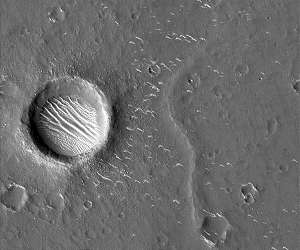A satellite on a science mission to Mars aims for a low-altitude orbit, but the lower the orbit, the more propellant is required to enter orbit when arriving from Earth. To save propellant, a technique called aerobraking uses a small propulsive maneuver for orbit insertion to enter a large orbit; the satellite then makes many passes through the upper atmosphere, using drag on the solar panels to reduce the size of the orbit a little bit each pass until the orbit is the desired size for science operations.
This aerobraking technique requires three to six months to complete and requires near-constant supervision by a ground team on Earth. Aerospace engineers at the University of Illinois Urbana-Champaign developed a way to use articulated solar panels to steer the satellite during aerobraking, reducing the number of passes needed, resulting in potential savings in propellant, time, and money.
“If we can rotate the solar panels, we can control how much drag is generated and we can actually steer during the atmospheric passes to control heating and energy depletion,” said AE Professor Zach Putnam. “This means we can fly much closer to operational constraints, and aerobrake much faster.”
Putnam’s Ph.D. student Giusy Falcone used the satellite’s ability to rotate their solar panels and calculated how the panels could be used to optimize and control the drag.
“Giusy developed a real-time algorithm that you might think of as an autopilot that uses information from the spacecraft’s onboard navigation system to determine the angle of the solar panels in real time, based on current atmospheric conditions,” Putnam said.
The primary limiting factor during flight is the temperature of the solar panels. When a satellite hits the molecules in the Mars atmosphere, the friction heats up the panels, and over-heating the solar panels can kill the spacecraft.
“Being able to steer the satellite during each atmospheric pass enables us to ensure we don’t over temperature the solar panels while flying much closer to the thermal limit. This is a big improvement. Instead of aerobraking for three to six months, it might only take a couple of weeks.”
This study is about automating just one pass through the atmosphere. This process would be repeated many times during a complete aerobraking campaign, Putnam said.
He explained that as the satellite’s orbit gets smaller and smaller, the time it takes to complete one orbit gets shorter until the orbits are so short that there isn’t time to transmit information from the spacecraft to Earth, wait for a decision, then send commands back to make a correction.
“Because it is automatic, Giusy’s algorithm is particularly helpful at that last stage when the orbits are very rapid, but the algorithm can be used for the entire process.”
This is the first piece toward developing an autonomous capability for aerobraking that has implications for reducing cost and mission risk on a much larger scale.
“The trip out to Mars takes somewhere between six to nine months. We can’t really change that, but we think we can shorten the time it takes to aerobrake to a low-altitude orbit,” Putnam said. “And the propellant onboard we save can be used to do other things like keep the spacecraft alive longer.”
Putnam said the current aerobraking method is also operationally intensive with a ground team working 24 hours a day for about six months.
“You can imagine how expensive it is for a ground team working around the clock,” he said. “There is also limited bandwidth for ground stations that can talk to Mars. We have only three and they’re oversubscribed as it is.
“This software would greatly reduce our reliance on ground stations. If we can automate it onboard and only have to check in with the spacecraft once a week, that would really bring costs down. And, it could be done by many satellites at the same time.”
Research Report: “Energy Depletion Guidance for Aerobraking Atmospheric Passes”
Related Links
University of Illinois Grainger College of Engineering
Mars News and Information at MarsDaily.com
Lunar Dreams and more
|
We need your help. The SpaceDaily news network continues to grow but revenues have never been harder to maintain. With the rise of Ad Blockers, and Facebook – our traditional revenue sources via quality network advertising continues to decline. And unlike so many other news sites, we don’t have a paywall – with those annoying usernames and passwords. Our news coverage takes time and effort to publish 365 days a year. If you find our news sites informative and useful then please consider becoming a regular supporter or for now make a one off contribution. |
||
|
SpaceDaily Contributor $5 Billed Once credit card or paypal |
SpaceDaily Monthly Supporter $5 Billed Monthly paypal only |
|

![]()
Consistent asteroid showers rock previous thinking on Mars craters
Perth, Australia (SPX) Jan 22, 2022
New Curtin University research has confirmed the frequency of asteroid collisions that formed impact craters on Mars has been consistent over the past 600 million years.
The study, published in Earth and Planetary Science Letters, analysed the formation of more than 500 large Martian craters using a crater detection algorithm previously developed at Curtin, which automatically counts the visible impact craters from a high-resolution image.
Despite previous studies suggesting spikes in the fr … read more